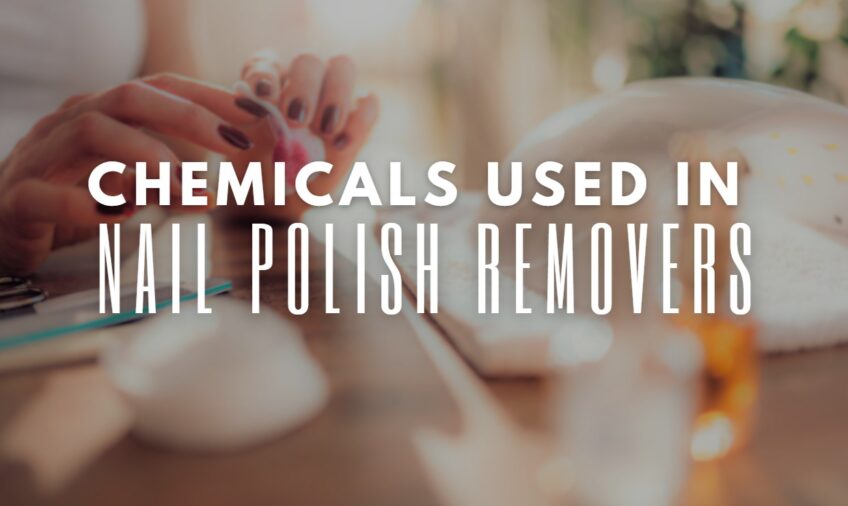Nail polish removers are liquids used to dissolve nail polish, allowing it to be removed from the nails. These products typically contain several chemicals that act as solvents, allowing the nail polish to be dissolved and wiped away. While there are several brands available, many of them use similar chemicals. Knowing about these common ingredients can help consumers decide if a particular product is suitable for their needs.
In addition to these two main ingredients, other chemicals may also be used depending on the specific product or brand being used. Propylene carbonate is often employed as an alternative to acetone due to its lower vapor pressure and reduced odor intensity; however, it can only dissolve certain types of polish due to its low solubility in water-based substances. Other compounds such as dimethylformamide (DMF) and ethylene glycol monomethyl ether (EGME) are also present in some products but may not be suitable for sensitive skin and other surfaces due to their strong solvent properties.
Types of Nail Polish Removers

They are special solutions used to remove nail polish from fingernails and toenails. They vary in composition and chemical content. While some are more gentle and more appropriate for sensitive skin, others are harsher and more abrasive.
Let’s explore the different types of nail polish removers available and their chemical composition.
Acetone-Based Removers
They are composed of several different types of chemicals and solvents. Common types of nail polish removers include acetone-based, non-acetone, and natural removers. Each type of remover is best suited for certain types of polishes, providing the safest and most effective solution for them.
Acetone-based removers are the most common type used today and may be found in stores as well as salons. Acetone removes most types of polishes quickly and effectively but has a strong odor that can linger even after use. It is often preferred as it can dissolve both regular nail colors as well as gels or other harder-to-remove products.
It is also usually inexpensive when compared to other options. As its active ingredient, acetone quickly vaporizes at room temperature so it tends to dry out nails faster than other ingredients which can become drying if used too often or abused by leaving them on for too long during application or removal.
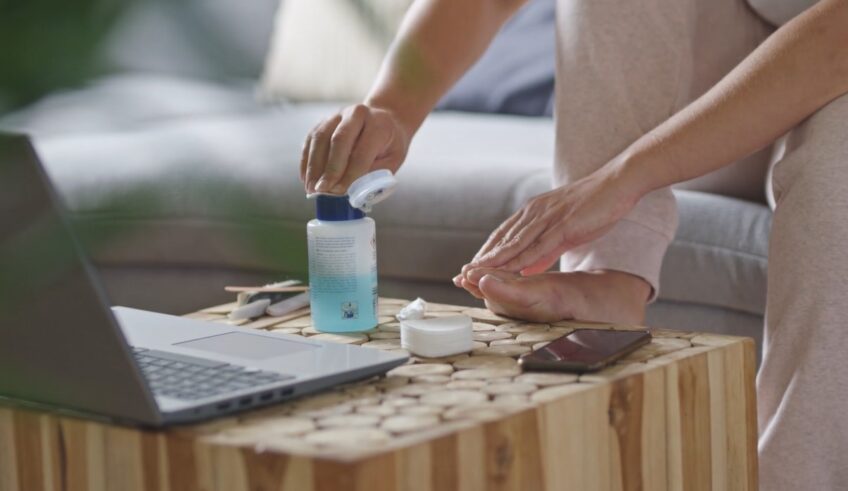
Non-Acetone Removers
For regular nail polish, the most common type of remover on the market is acetone-based. But there are alternatives available in the form of non-acetone removers. These are usually gentler on nails because they don’t contain harsh chemicals such as toluene, dibutyl phthalate, and formaldehyde which can have adverse effects. Non-acetone removers also do not emit strong odors like acetone removers do.
They typically contain a mix of effective yet gentle solvents such as ethyl lactate, ethyl acetate, and propylene carbonate. They may also contain other ingredients for softening the cuticles, so read labels to be sure that you’re buying a product that works for your needs. Examples of non-acetone nail polish removers include:
- Tea Tree Oil Based Remover – This product is enriched with tea tree oil to condition and nourish nails while also providing long-lasting results without drying out natural nails or cuticles at all.
- Citrus-Based Remover – This type utilizes naturally derived citrus extracts to easily remove old color while moisturizing your hands and nails at the same time! Plus it comes in a convenient pump dispenser so no spilling!
Common Chemicals Found in Nail Polish Removers
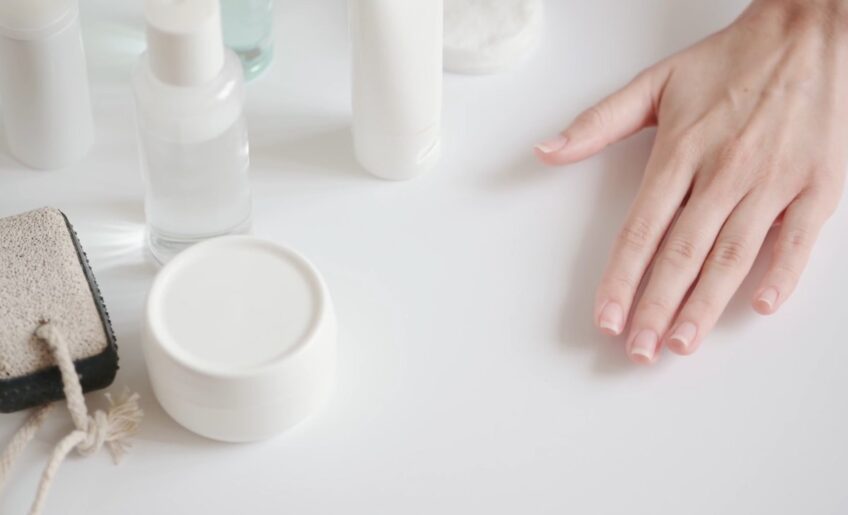
They contain a variety of chemicals that work to remove the polish from nails. Some of the most commonly used chemicals include isopropyl alcohol, acetone, ethyl acetate, and acetonitrile.
Each of these chemicals has its own unique properties and characteristics that contribute to the effectiveness of the polish remover.
| Chemical Name | Function | Features |
| Acetone | Solvent | Fast-acting, strong odor, drying to skin and nails |
| Ethyl Acetate | Solvent | Effective, less drying than acetone, fruity odor |
| Butyl Acetate | Solvent | Slow-acting, less strong odor, less drying than acetone |
| Isopropyl Alcohol | Solvent | Mildly effective, less strong odor, less drying than acetone |
| Propylene Carbonate | Solvent | Mildly effective, less strong odor, less drying than acetone |
| Glycerin | Moisturizer | Helps prevent drying of skin and nails, less effective as a solvent |
| Water | Diluent | Often used to dilute and reduce the strength of other solvents |
Toxic Chemicals
| Chemical Name | Function | Features |
| Formaldehyde | Hardening Agent | Strong odor, can cause skin irritation, respiratory problems, and may be carcinogenic |
| Toluene | Solvent | Strong odor, can cause headaches, dizziness, and can be harmful if ingested or inhaled in high amounts |
| DBP (Dibutyl Phthalate) | Plasticizer | Can disrupt hormone function, cause developmental problems, and may be carcinogenic |
| Camphor | Plasticizer | Can cause skin irritation and allergic reactions, and may be harmful if ingested in large amounts |
| Xylene | Solvent | Strong odor, can cause skin irritation, headaches, and dizziness, and can be harmful if ingested or inhaled in high amounts |
Let’s discuss the details of each of these chemicals and what they can do.
Acetone
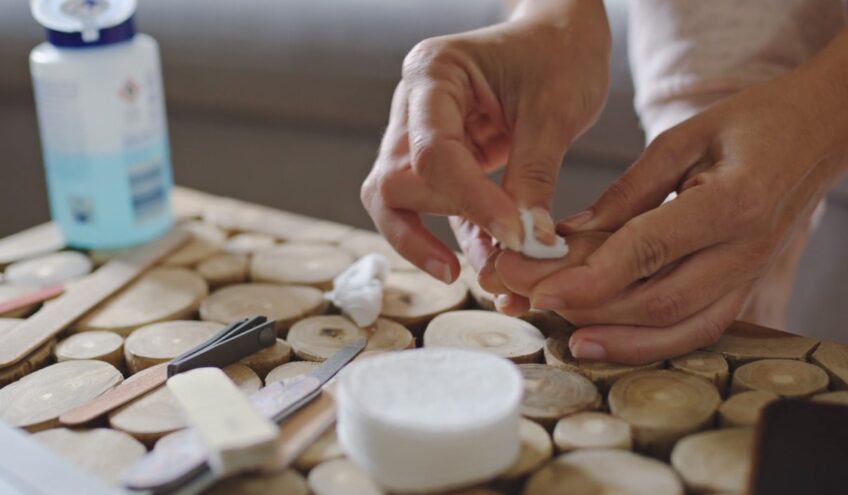
Acetone is a colorless, volatile liquid that is often used as an industrial solvent. It is also found in nail polish removers, so when you opt for an acetone-based solution, you can anticipate that your nail polish will be removed quickly and effectively. It has a distinctive smell and is sometimes referred to as a “fingernail polish remover” due to its ability to dissolve most types of commercial nail polishes. Acetone evaporates quickly, making it useful when you need a fast-acting nail polish remover that works almost instantly.
It is recommended for spot treatments with dark or stubborn polishes since it does not contain any conditioning additives such as oil or lanolin. Allowing your nails to soak in acetone can damage the nail bed, so it’s important to avoid overuse of this type of remover. Additionally, acetone may affect your plastic bathroom fixtures and other surfaces if over-applied.
As with any chemical product, acetone should be handled with care and caution for safety reasons and the proper effectiveness of results.
Ethyl Acetate
Ethyl acetate is one of the most common ingredients found in nail polish removers. It is a colorless liquid with a sweet aroma that is often used in foods, drugs, lacquers and printing ink.
This chemical solvent can be toxic if ingested internally and may cause irritation to the eyes and lungs. It has a low boiling point so it evaporates quickly, leaving no trace behind. Ethyl acetate is also highly flammable and should always be used in a well-ventilated area or outdoors.
Isopropyl Alcohol
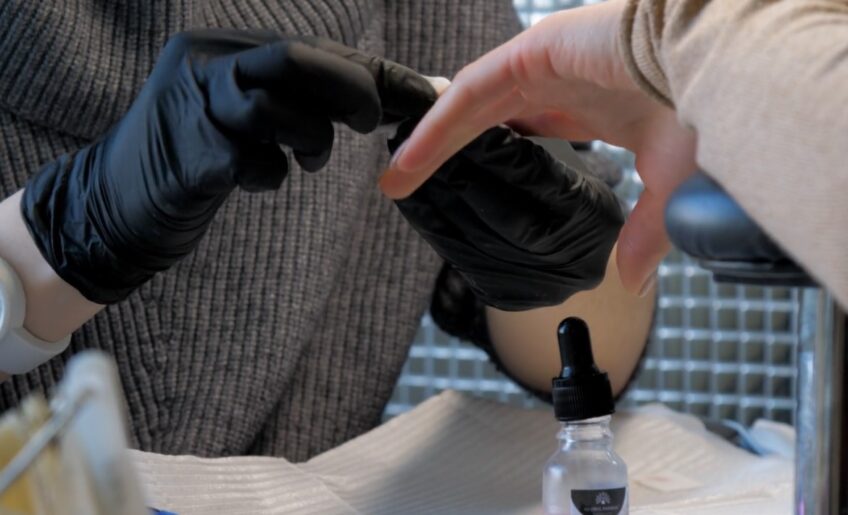
Isopropyl alcohol is the most common chemical used in nail polish removers, although acetone is another option for those who prefer to avoid it. Isopropyl alcohol is a clear volatile liquid that has a powerful antiseptic odor. It works by breaking down the cell bonds and loosening the nail polish from the nails, allowing for easy removal. It is known to be gentle on skin and nails but when used in high concentrations, can irritate skin or act as a mild anesthetic.
Be sure to wash your hands thoroughly before and after using any type of nail polish remover containing Isopropyl Alcohol.
Propylene Carbonate
Propylene carbonate, also known as propane-1,2-diol, is one of the most common chemicals found in nail polish removers. It acts as a solvent to break down and dissolve the film of nail polishes on the nails.
When used in nail polish remover, it is typically used in combination with other chemical compounds such as ethyl acetate and/or ethyl lactate to create a formulation that works best for removing a variety of nail polishes and finishes. Its chemical properties make it an ideal component for fast-acting removers without causing too much drying or damage to nails and skin.
Butyl Acetate
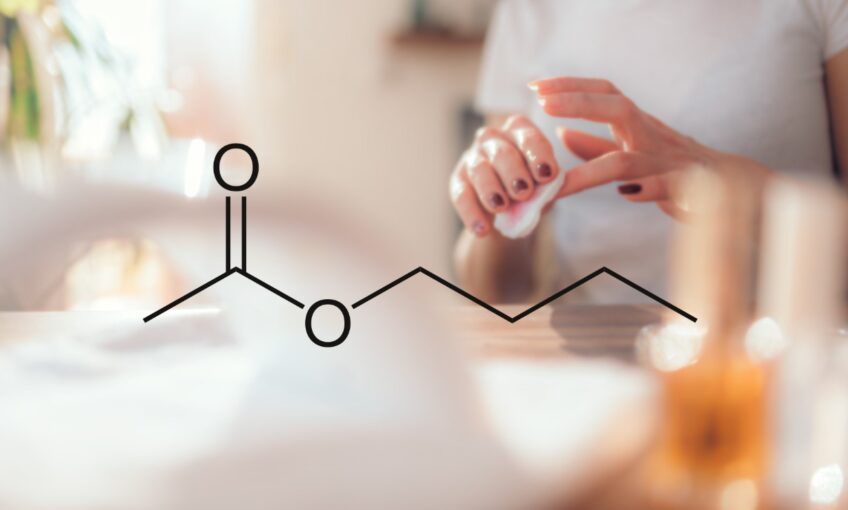
Butyl Acetate is a colorless, flammable liquid with a fruity odor. It is derived from wood, petroleum, and even animal sources. Although it has low toxicity, it causes irritation when ingested or inhaled.
This chemical is commonly found in many of the nail polish removers that you can buy in stores as a solvent. As well as being used in nail polish removers, this chemical can be found in other cosmetic products such as perfumes and hairsprays. The chemical is also commonly used as an industrial solvent for nitrocellulose lacquers, oils, waxes and plastics.
Ethanol
Ethanol, or ethyl alcohol, is commonly found in nail polish removers because of its effectiveness at removing polish while also giving a pleasant scent. As it is an extremely flammable substance, it is often blended with preservatives and other chemical compounds such as acetonitrile, dimethyl ether, and fragrances.
While fingernail polish contains mostly harmless chemicals, ethanol can be harmful if too much is absorbed through the skin; therefore, when purchasing removers for home use, those without ethanol are always recommended. Additionally, careful application should always be observed to prevent any potential injury from the nails being removed.
Health Risks Associated with Nail Polish Removers
There are a variety of chemicals used in nail polish removers, and understanding the ingredients can help us make healthier choices. They often contain harsh chemicals like acetone, ethyl acetate, and isopropyl alcohol. While these chemicals can be helpful in removing nail polish, they can also pose a health risk when inhaled or absorbed through the skin.
Let’s take a look at the possible health risks associated with nail polish remover chemicals.
Skin Irritation
Nail polish removers contain chemicals that can cause skin irritation if exposed for too long or too often. Most types contain acetone, ethanol, isopropanol, or combinations of them. Acetone and isopropanol are mainly used for fast-acting nail polish removal. Ethanol is used more often as it does not evaporate as quickly and is safer for both skin and the environment.
The use of pure acetone in nail polish removers can lead to dryness, cracking, and peeling of the skin due to its strong solvent abilities. A buildup of these chemicals on the skin can cause contact dermatitis, an allergic reaction that results in red, itchy skin that can later lead to blistering or even infection if scratched open. Prolonged contact with any type of chemical should be avoided to minimize health risks associated with skin irritation caused by nail polish removers.
It’s important to read labels carefully and select products that are specially formulated for use on nails and do not contain harsh chemicals such as acetone. Look for natural alternatives like essential oils as well as products specifically designed to lock in moisture during application so that your nails will stay healthy and beautiful throughout your manicure routine.
Respiratory Issues

They contain a variety of chemical compounds, many of which can irritate or damage the lungs and airways. One popular ingredient is acetone, which is extremely volatile and has a distinctive odor that you may be familiar with in salons and other beauty care establishments. Acetone can cause dizziness, headaches, or even nausea in exposed individuals. Long-term exposure has been linked to respiratory problems like asthma, bronchitis, and inflammation of air passages.
Other common ingredients in them are ethyl acetate and toluene, both of which can also irritate lung tissues if inhaled directly from the container or from evaporation after use.
It’s important to always keep your workspace well-ventilated when using it to prevent these respiratory problems from occurring. This means making sure there is sufficient airflow throughout the area; open windows or use fans when necessary for extra ventilation if needed. You should also wear protective eyewear and gloves at all times when working with chemicals; industrial masks are available for those who are particularly sensitive to odors or airborne particles.
Eye Irritation
Eye irritation is one of the most common hazards associated with them. The acetone and other chemicals used in some of these products can cause symptoms ranging from mild discomfort to blindness. It’s important to avoid contact with open eyes and if this happens, be sure to rinse your eyes with lukewarm water as soon as possible. If the irritation persists, seek medical care right away.
It is also important to remember that when using them in any form, such as liquid or wipes, always ensure adequate ventilation to prevent exposure to the fumes. If working in an enclosed space without adequate ventilation, it is recommended that a face mask be worn for protection against inhalation of hazardous fumes.
Nausea
Removers that contain the active ingredient acetone can cause users to experience a variety of health issues upon inhalation, including nausea. They are organic solvents that contain volatile organic compounds (VOCs) like acetone, which generate strong odors and can strongly influence air quality in an enclosed area.
When the vapors from these chemicals are inhaled, they can cause irritation to the mucous membranes of the nose, throat, and respiratory tract. This irritation may lead to symptoms such as coughing, sore throat, and hoarseness. Additionally, it may also produce symptoms such as nausea and dizziness. Symptoms may be more severe when using stronger ones in smaller spaces with poor air circulation.
Unlike many other forms of chemical exposure, opting for non-acetone nail polish removers does not always alleviate the side effects caused by using them. Non-acetone nail polish removers typically contain fewer VOCs than traditional types of nail polish removers but still release some of these substances into the air causing users to experience many of the same adverse health effects associated with acetone-based products. To avoid any potential health risks associated with these products it’s important to ensure you use them in well-ventilated areas or take breaks outdoors if available while applying them at home.
FAQs
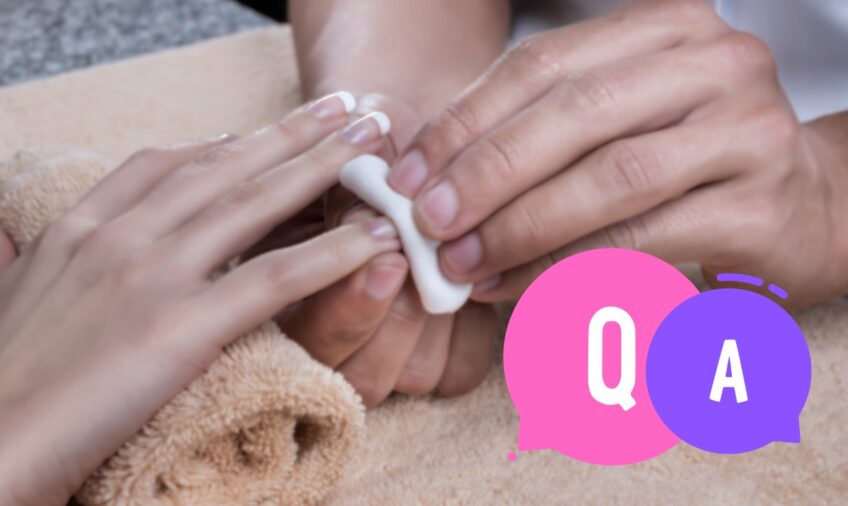
Are there any long-term effects of using nail polish removers?
Prolonged use of removers containing harsh chemicals can lead to thinning and weakening of the nails, making them more prone to breaking and chipping.
Can nail polish removers cause allergic reactions?
Yes, some people may be allergic to the chemicals used in them, leading to skin irritation and rashes.
Are there any eco-friendly nail polish removers available?
Yes, there are ones available that are made with natural ingredients and are free from harmful chemicals.
How can you dispose of nail polish removers safely?
It is important to dispose of them properly by taking them to a hazardous waste facility or following the instructions on the label for safe disposal.
Can pregnant women use nail polish removers?
Pregnant women should avoid using them, and it is best to use natural alternatives instead.
What are the risks of inhaling the fumes from nail polish removers?
Inhaling their fumes can cause dizziness, headaches, and nausea, and can even lead to more serious health problems with prolonged exposure.
Can nail polish removers damage furniture or other surfaces?
They can be harsh and cause damage to furniture or other surfaces, so it is important to use them with caution and to clean up any spills immediately.
Can children use nail polish removers?
Children should not use them without adult supervision, and it is best to use natural alternatives that are safe for children.
How can you protect your skin while using nail polish removers?
It is important to protect your skin by applying a barrier cream or lotion before using them and washing your hands thoroughly after use.d
Conclusion
In summary, there are various chemical substances that make up nail polish removers, and the composition can depend on the brand. Common chemicals often found in this product include acetone, ethyl acetate, methyl acetate, isopropyl alcohol, and other solvents. Nail polish removers may also contain oils, moisturizers, or conditioners to help keep the nails from becoming overly dry or damaged as some ingredients can be harsh on the skin.
However, nail polish removers are not the only beauty products that require caution; makeup safety is equally important. By staying informed about the ingredients used in cosmetics and skincare products, you can make informed decisions to protect your health while maintaining your beauty routine.
When choosing a nail polish remover or makeup, always read the product’s label carefully to ensure that you are comfortable with its ingredients and that it is suitable for your needs. If you have any doubt about a particular product’s safety, it is best to consult a dermatologist for further guidance.

